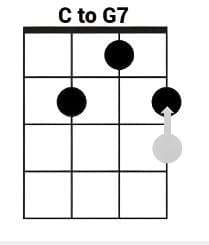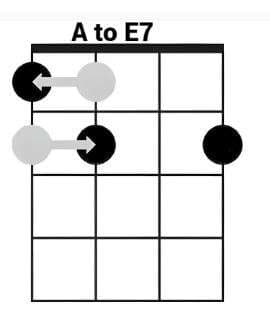
The average player puts a lot of effort into learning how to change ukulele chords quickly. Developing the ability to change chords speedily is possible by practicing constantly alternating between chords very slowly, beginning with two chords at a time, and doing it over and over.
As you do this more often, the chord changes get more seamless because your muscle memory will remember it when you attempt to alternate between chords.
This short lesson will show you some tips on how to change chords quickly.
4 Tips on How to Change Ukulele Chords Quickly
Looking Ahead
The fact is that once you obtain your fingers for a chord, you never have to ponder retaining the chord. Only hold down your fingers, and the notes will keep playing.
There is no reason not to guess what the subsequent chord will be. By pondering it in your brain and planning what steps to take to change your fingers, you might become more ready while changing chord times.
The rapid changes occurring on the beat or every other beat may not permit such planning in advance and will still confuse you. But for any anthem that only goes through the chords once per bar, I ponder that you’ll see that you can change ukulele chords a lot faster.
In the case of recommending it to beginning students, an immediate improvement in their ability can be seen following even the simple ukulele songs. In place of concentrating on the chord they stay on, they get aware of what needs to occur next and where the instrument part is about to go.
Hovering Over The Board
An additional “look ahead” concept is to rotate your fingers over the next position where they should be placed.
Any fingers you’re not utilizing to hold down a chord can be moved into a “ready” position for the next fret they are about to play.
A general example is if players hold an A minor chord and wish to change to F. When holding down A minor with their middle finger on the 2nd fret, top string, players roll their index finger over the 1st fret on the E-string.
It permits you to “plop” the finger while changing chords, and you do not have to worry about fretting the F. I can pick up the groundwork before the chord alterations occur.
String it simultaneously
The first space to append the dots between chords lies along the path of a string. When one finger is on the identical String but strums the next chord, just let go of that finger on the String. Just elevate up slightly, transfer, and then push down again.
For example, it is difficult for beginning players to change from a C-chord to a G7 chord. But by applying this technique, you can defend mental space by placing the 3rd finger on the bottom String.
As the correct fingering technique employs the 3rd finger to play a C chord, you can let go of that finger on the String while switching to G7. Just glide the third finger down a fret on the string, and then affix the other two fingers to complete the shape (perhaps in a “hover” technique?).
When going back to C, accomplish the reverse.
Another instance to aid you in understanding the conception is the change from G to D7 chord. Please remember that a reference is the Hawaiian D7 fingered: 2020.
The correct fretting technique for a G chord is placing your 1st finger on the 2nd fret of the C-string, your middle finger on the 2nd fret of the A-string, and your 3rd finger on the 3rd fret of the E-string. Now to alter to the D7, you will put your 3rd finger on the E string. Elevate up the 1st two fingers, glide the 3rd finger down a fret, and affix the mid-finger to the top String, 2nd fret.
The opposite is true for reverting from D7 back to G.
Shared Frets
Although the same-string method becomes very helpful, it is rare enough that we require a substitute for additional simple chord movement and visualization. Indeed, it arrives at us through magical metal fret lines.
You can utilize it as a memorization device when switching between chords that share a finger on the same fret. All you have to do to change is move the finger to the subsequent string.
Say we desired to alter from a major chord to an E7 chord. As there is no practical space where we can glide a finger up or down to change, we have to search for alternatives.
The most conspicuous thing is apportioning your mid-finger on the 2nd fret of the top string of the A chord, with the 2nd fret on the C-string for E7. It also becomes true for your 1st finger on the 1st fret of the C-string on the A chord. You can lift this finger up to the top string to structure the base of the E7.
Final Note: How to Change Ukulele Chords
Here are some simple, straightforward tricks to supercharge the chord alterations you do on your instrument. They are in no way the only devices to reduce your workload, but some are straightforward with the ideal benefit-to-effort ratio.


